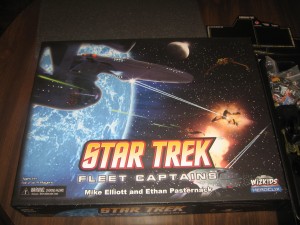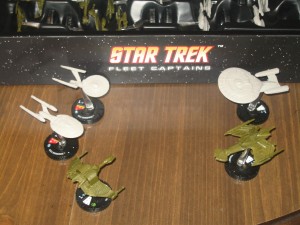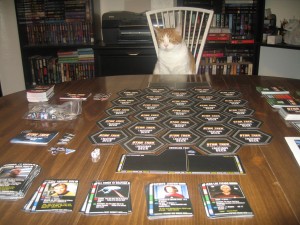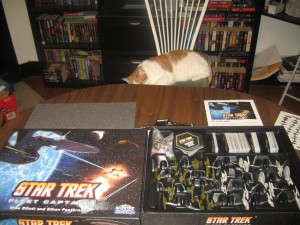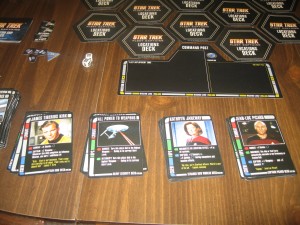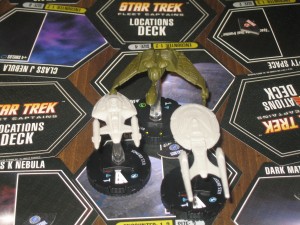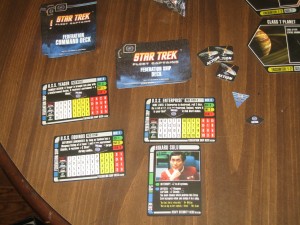Finally, a Star Trek game where I can fly ships around my head like I did when I was twenty-five eight…the rapid fire shooting noises, the impossible one hundred and eighty degree turns…it’s almost as if it was like yesterday twenty-two years ago. “PEWWWWWW! PEWWWWW! CHHHHHHHHHHHKKKKKK… VERRRRRRROOOWWMMMMM!!! PEW PEW PEW PEW!!!!”
Okay, maybe I’m a bit old for that now (PEEEEWWW PEWWWWWW!!!) but it is honestly refreshing to find a board game that finally pits the Federation against the Klingons using detailed ship models. On top of the cool looking ships, there are locations to explore, missions to complete, battles to wage, encounters to survive, and a fleet to manage.
When I first began reading the rules, I was instantly reminded of Star Trek: The Next Generation – The Customizable Card Game. In that card game, you had location cards with missions under them that you sent your ship and crew cards to go complete. Missions required a specific number of skill checks that only particular crew members might specialize in. On the other side of your location cards was where your opponent was managing their fleet and crew, trying to do the same missions you were. On occasion you would do battle, but your goal was to complete missions in order to win the game.
Fleet Captains isn’t exactly like that, but I can safely say that there are similarities.
Before I begin, I want to get out of the way now that I will not be covering ALL of the rules and features, but I’ll include as many as I can. Some of the mechanics would take too long to explain…the cloaking mechanic and sensor echos, for example. Also, this article is picture heavy so some photos may not load correctly. This problem can be solved by refreshing the page. In fact, all problems can be solved by refreshing this page. Just go ahead and do it…about fifty times. I’ll wait, honest.
Setup
The game can either be played as a one on one game or a two on two game. I’m sure if you got creative you could make your own variants. For the purpose of this review, I’ll cover the standard one versus one game.
First, the playing field is set up. Hexagonal location cards will make up “the final frontier” and be placed face down in either a preset order or a design of your own choosing. These location cards contain stars, nebulas, habitable planets, deep space…you name it. Each location varies in regards to size, bonuses, penalties, and the die roll you need to avoid a random encounter. The Klingon and Federation HQs are placed adjacent to these location tiles so that ships can go out and explore them.
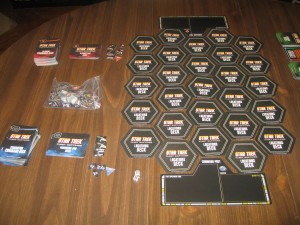
The standard playing field is a 5/6/5/6/5 grid, but experienced players are encouraged to get creative.
One player picks the Federation and one player picks the Klingons. Each side will draw starship cards that vary in value to account for their individual strength. A battle cruiser is worth a lot more than say, a small science vessel with weaker stats. Players draw starship cards until their value is exactly “10″ and get the appropriate ships from the box to place on their home base / HQ. Ships have multiple power settings that can be adjusted to compliment shields, weapons, sensors, and/or engines. They also have a yellow alert and red alert group of power settings that indicate that the ship is damaged. Ships on red alert aren’t as powerful or have as many power distribution options as one fully repaired. You can adjust the power setting by turning the base of the stand holding up the model ship.
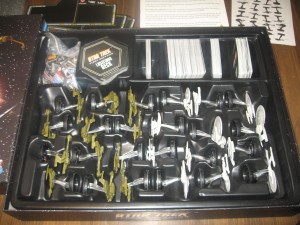
Not to worry, you won’t be stuck with the same ships each game. When I first opened the box and saw all of those ships, I could have sworn I heard trumpets and an opera lady singing.
Next, players will draw ten mission cards. Mission cards are either science, influence, or combat oriented. Each ship that was drafted tells you how many mission cards and of what type to draw of each. If your fleet ended up being a bunch of smaller science vessels, you’ll be drawing a lot of science mission cards. Mission cards are a way to gain victory points…in a standard game, scoring ten victory points makes you the winner. Each player draws three mission cards, face up, to serve as their active missions. Secret missions are kept face down.
After that, players get to pick four premade “subdecks” and place the rest back in the box. These premade subdecks specialize in various things…so be sure to pick the decks that compliment the missions you are attempting. These subdecks contain crew cards, interrupts, and other bonus cards that will help give you an edge when facing peril. The four subdecks you choose will be shuffled and serve as your main “command deck” for the game.
Winning The Game
Players will need to reach so many victory points to win the game. The standard game is ten “VPs” however they can shorten or lengthen the game by adjusting that figure.
You can gain VPs by doing missions, succeeding at encounters, building starbases, blowing up enemy ships, and possibly through other means like subdeck cards.
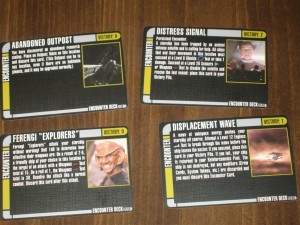
Some random encounters are down right brutal, though some of them can give you the points you need to push you ahead to victory.
Gameplay
There’s quite a bit you can do on your turn, but I’ll sum it up as best I can so as not to put new readers into a coma.
1) Move each ship in your fleet.
2) Make one power adjustment, per ship.
3) Play any cards from your command deck.
4) Place one of your three active mission cards back into your mission deck and draw a new one.
5) Discard any one of your command cards and draw a new one.
6) Take three actions. Actions can be a number of things, including cloaking a ship, attacking an enemy vessel, calling for reinforcements, placing an influence token on a location, repairing a ship, scanning an unexplored sector, using the transporter, and participating in a systems test for missions. The player is limited to one action per ship.
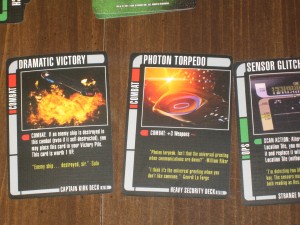
Don’t forget about your command cards. Including a command card during a systems check can sometimes make all the difference.
A Word On System Tests & Battles
Throughout the game, you’ll be required to “test” one of your ship’s systems, be it from an encounter, an enemy attack, or what have you. Generally, these are resolved as follows:
Ship’s base system rating + 1 Friendly Command Card Bonus (optional) – 1 Enemy Command Card Penalty (optional) + Ship’s Crew Bonuses + Die Roll = Pass or Fail.
When two ships are in combat, the above formula serves as the aggressor’s attack power. That figure is then compared to the defender’s shield value. If the attacker’s attack power is more than the defender’s shield power, then damage is inflicted and the defender loses an “alert status.” If the attack power value is double that of the shields, the defenders suffers two hits and loses two “alert statuses”. If the attack power value is three times that of the shields…well…kablooey.
A Word On Influence Tokens
Influence tokens can be placed on any location you’re in, assuming there are no enemy ships or influence tokens present. Influence can satisfy certain missions as well as allow you to build installations on habitable planets. These serve as repair facilities for your ships so that you don’t have to limp all the way back to HQ. Starbases, the largest installation, also nets you VPs.
A Word On Reinforcements
Players start out with ten points in regards to their fleet pool. When a player’s ship is destroyed, their pool’s maximum value increases by one. When taking a reinforcement action, a player will draw a ship card to call in a new ship at HQ, but the value of that ship can’t pass the maximum fleet pool.
Let’s say that the Klingons lose their first ship valued at 3 but the rest of their fleet remains intact. As a result, their fleet pool’s maximum value increases by one, bringing the status of the fleet to 7 out of 11. The Klingons, when taking a reinforcement action, can draw a new ship up to a value of 4.
The Review
As an avid Star Trek fan, it’s hard not to be biased. The ship models look fantastic and all of the cards, whether they are command cards, mission cards, or encounter cards, stay true to the Star Trek theme. The game tray is also top notch…each ship has its own compartment.
If I had to complain about anything, it would be the Clix feature’s functionality. The idea is GREAT, don’t get me wrong, but some of the ship’s Clix stats are difficult to change…that is…the base is physically difficult to turn. Rather than risk breaking the model and its base, I got creative and used influence tokens to point to the current power setting on the ship card. It works, so as long as nobody bumps the table or decides to play the game inside a wind tunnel. Rather than worry about your eleven year old (or you) breaking the ships, all that needs done is to slide the influence token on the card over to the new setting.
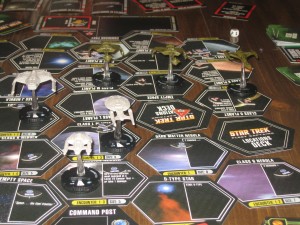
Constantly changing a ship’s power settings can be a real chore…though some of the Clix figures work better than others.
My son and I had an excellent time playing, though I appreciated it more seeing as how I was more familiar with the ships and the lore. In the game we played, he pulled his Klingon forces ahead of mine in an early 0-2 lead after finding two habitable planets adjacent to his HQ and building a starbase on each after several influence actions and upgrades.
Meanwhile, my Enterprise E boldly went…exploring ten adjacent tiles to satisfy an active mission. So it went, back and forth, a VP here, a VP there, until he got brave and attacked the weakest ship in the task force I had created to satisfy a mission for some VPs…though on my next turn I blew his Bird of Prey out of the water to score my own VP.
I ended up winning, 10 to his 6, mainly because I was able to do my science missions faster than he could muster his forces to satisfy his combat missions. The Klingons are very combat heavy it seems, as they should be. Players familiar with the Zerg Rush tactic in Starcraft would probably do well when playing the Klingon side.
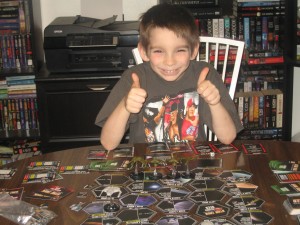
My eleven year old was confused a few times throughout the game, mainly due to the game’s age requirement. Regardless, he seemed to enjoy his experience. His favorite part, he claimed, was managing a fleet.
Overall, the game was a lot of fun. The price for the product is pretty high so casual gamers should tread lightly. I recommend this game for serious Star Trek fans who have experience playing more complex board games. For those of you who are buying it, expect to take some time to review the rules a few times before and during the game.
Final Verdict: 8/10

